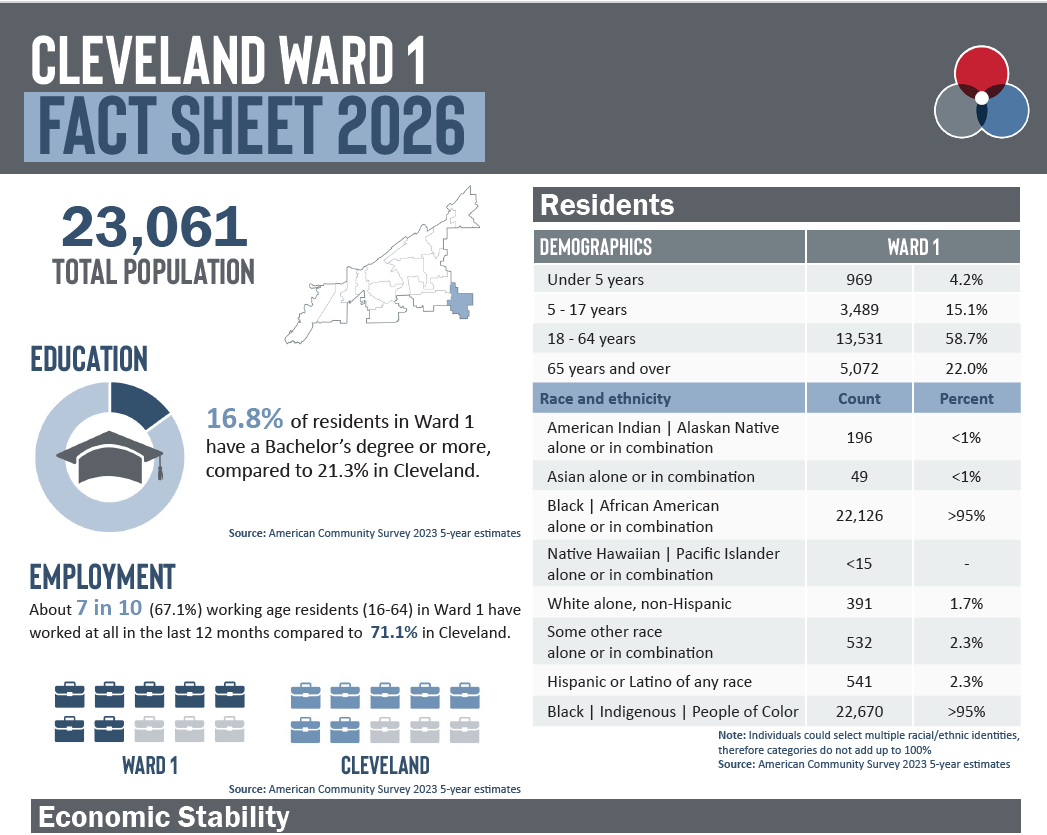Fact Sheets
We make data digestible. Community Solutions produces fact sheets highlighting demographic, health, and social indicators for communities around Ohio. We examine data indicators within poverty, education, employment, income, health outcomes, and public benefit programs. Policymakers and direct service organizations use this resource to better understand the communities they serve and advocate for improved health and social conditions around the state. Interact with the data using this worksheet.

Cleveland Wards 2026
Cleveland Ward fact sheets and data profiles highlight demographic, health, and social indicators in the new 15 wards in Cleveland. The fact sheets summarize and the data profiles provide extensive information about each ward on employment and income, poverty, education, housing and health. This is the first analysis available for Cleveland's revised wards, now 15 from the prior 17. Data released 2025.

Cleveland Neighborhoods
City of Cleveland Neighborhoods fact sheets and data profiles highlight demographic, health, and social indicators in the City of Cleveland. The fact sheets summarize and the data profiles provide extensive information about each neighborhood on employment and income, poverty, education, housing and health. Data released in 2016, 2021, and 2024.

Federal Congressional Districts in Ohio
These fact sheets explore demographics, economic stability, food security, housing, education and employment, health, and funding sources in each of Ohio's 15 Federal Congressional Districts. Data from 2025. Check out the interactive worksheet.

Medicaid in Ohio by County
More than 25 percent of Ohio's population receives health care coverage from Medicaid. These fact sheets explore those covered populations, work requirements, and the potential for coverage loss if policy or funding changes are made to the program. Data released 2025.

Cuyahoga County Council Districts
Cuyahoga Council District fact sheets highlight demographic, health, and social indicators in the City of Cleveland. The fact sheets summarize and the data profiles provide extensive information about each district on employment and income, poverty, education, housing, and health. Data released 2017 and 2024.

Cuyahoga County Municipalities
These fact sheets and data profiles highlight demographic, health, and social indicators in the cities, townships, and villages of Cuyahoga County. The fact sheets summarize and the data profiles provide extensive information about each Municipality on employment and income, poverty, education, housing, and health. Data released 2018 and 2024.

Geauga County Municipalities
These fact sheets and data profiles highlight demographic, health, and social indicators in the cities, townships, and villages of Geauga County. The fact sheets summarize and the data profiles provide extensive information about each Municipality on employment and income, poverty, education, housing, and health. Data released in 2024.

Status of Women
Ohio enjoys a high rate of health care coverage, at 95%. Yet maternal health challenges continue to impact the health of women and their families. Women are more likely to be caregivers, and Ohio mothers work at rates higher than the national average. Even when working, Ohio women with children are more likely to live in poverty. Having children increases the likelihood of living in poverty by four-fold. Data released in 2023.

Lake County Municipalities
These fact sheets and data profiles highlight demographic, health, and social indicators in the cities, townships, and villages of Lake County. The fact sheets summarize and the data profiles provide extensive information about each Municipality on employment and income, poverty, education, housing, and health. Data released in 2024.

Ohio Legislative Districts
By matching Census block groups with the boundaries of Ohio’s new legislative districts, then to data points from the U.S. Census Bureau, we created fact sheets for each of the 132 legislative districts. Fact sheets include demographic information about each district, as well as district-level data on employment and income, poverty, education, housing, and health. Data released in 2023.

Cleveland Wards 2022
City of Cleveland Ward fact sheets highlight pre-pandemic demographic, health, and social indicators in the City of Cleveland. The fact sheets include basic demographic information about each neighborhood and pre-pandemic data on employment and income, poverty, education, housing and health. Data released 2021 and 2022. Updated with new ward configuration in 2026.
